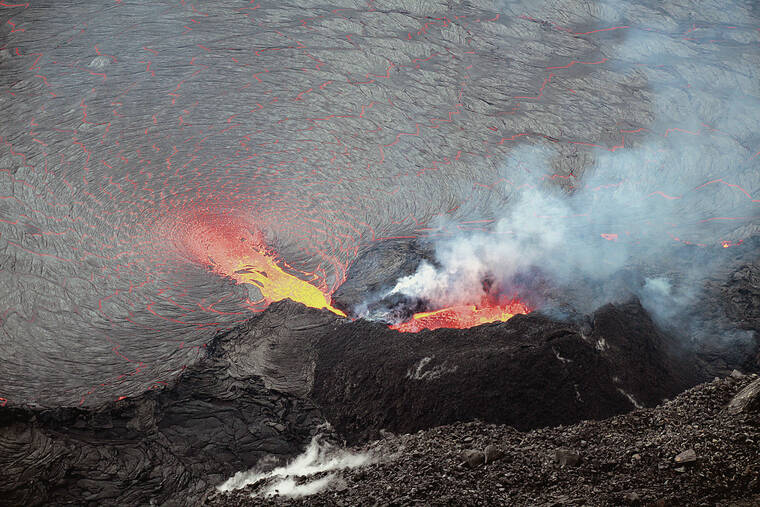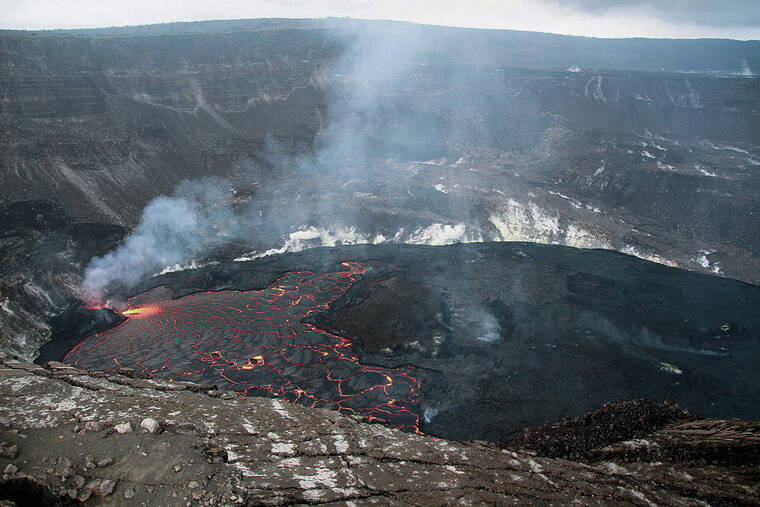Kilauea eruption continues to draw visitors

N. DELIGNE / USGS
View of the west vent within Halemaumau Crater, at the summit of Kilauea, as seen from the western crater rim Friday. Ponded lava within the west vent cone continues to flow down a spillway and into the lava lake.

N. DELIGNE / USGS
A wide view of the lava lake in Halemaumau Crater, at the summit of Kilauea, on Friday. This view, looking north, shows the west vent, left, which continues to supply lava to the active portion of the lava lake, while the eastern, right portion is crusted over. The active lake is primarily between the west vent source and the main island, center.


Kilauea has entered the second month of its current eruption, having evolved from its initial show of multiple lava fountains to a steady spurting of molten rock from a single vent within the summit crater.
But the volcano still remains popular. Despite it being the slow season for tourist visitation, Hawai‘i Volcanoes National Park remains busy, particularly before sunset and sunrise, with at least 2,500 visitors a day.
“Everyone wants to see lava,” park spokeswoman Jessica Ferracane said Monday. “The view is fantastic.”
Hawaiian Volcano Observatory scientists said that while all the lava action remains in Halemaumau Crater, seismic activity and volcanic gas emission rates remain elevated.
But the volcano’s behavior isn’t quite as spectacular as the initial days of the eruption starting Sept. 29. The multiple vents that shot lava dozens of feet into the air have been replaced by low roiling and spatter bursting by a single vent on the western side of the crater.
The amount of sulfur dioxide emitted — a key indicator of the lava effusion rate — has dropped from 85,000 metric tons per day (one metric ton equals 2,200 pounds) to around 3,600 tons a day.
Don't miss out on what's happening!
Stay in touch with breaking news, as it happens, conveniently in your email inbox. It's FREE!
No significant changes have been seen in summit tilt or GPS observations for weeks, officials said.
While the amount of lava being spewed into the crater has slowed, the lava lake continues to rise. On Monday its elevation was measured 167 feet higher than it was at the start of the eruption. Scientists have estimated that more than 4 billion gallons have been pushed into the lava lake over the past month.
But the lake is not level. There’s a 26-foot elevation difference between its active west end and its stagnant eastern section, as measured by HVO field crews last week.
Meanwhile, there has been no unusual activity noted in Kilauea’s east rift zone, site of the volcano’s four-month-long destructive 2018 eruption. Ground deformation measurements in the upper east rift zone area — between the summit and Puu Oo — suggest that refilling of magma since late August has slowed down slightly, scientists said.
Volcanologists have said Kilauea could be entering a new eruptive phase in which the lava flow is confined to the crater. The volcano’s last eruption lasted five months — from Dec. 20 to May 25 — and its lava stayed all within the crater.
Scientists say it’s not uncommon for the most active part of an eruption to occur at the beginning. In both recent summit eruptions, the highest lava fountaining occurred at the start. By contrast, the highest fountaining during the 2018 eruption didn’t occur until nearly a month after the eruption started because of the magma pushing out older, cooler magma.
The 2018 eruption destroyed 716 homes, forced the evacuation of 2,000 residents and caused damage estimated at more than $800 million as it transformed the Lower Puna landscape and created new land.
If you want to see Madam Pele’s latest outburst, the best thing to do is to make your first stop the Hawai‘i Volcanoes National Park website for eruption viewing information, Ferracane said.
Hawai‘i Volcanoes National Park:
>> Visit the website at nps.gov/havo/index.htm Opens in a new tab.



